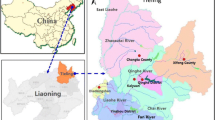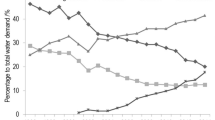Abstract
As one of the most rapidly developing cities in China, Shenzhen grapples with an increasing challenge in managing water resources due to escalating conflicts with its soaring water demand. This study established a system dynamics (SD) model based on a causal loop diagram to explore the intricate interconnections within the urban water resources system. Through simulating water supply and demand in Shenzhen from 2021 to 2035, the model identified key sensitive factors and examined various utilization scenarios for multiple water resources. Results indicated that water scarcity posed a significant obstacle to Shenzhen’s development. To tackle this challenge, several effective measures should be implemented, including enhancing water conservation capabilities, developing seawater resources, promoting water reuse, optimizing the economic structure, and managing population growth. Prioritizing water conservation efforts and maximizing the utilization of seawater resources were regarded as the most impactful strategies in alleviating the water crisis. Furthermore, the relationship between water conservation capabilities and seawater utilization scale was analyzed using the SD model, contributing to the development of a comprehensive water resources management strategy. The findings from this study would provide insights into robust methods for allocating water resources, thereby enhancing sustainable water management strategies applicable to regions facing similar challenges.








Similar content being viewed by others
Data availability
Applicable.
References
Abraham M, Venugopal K, Arunkumar R, Pramada SK (2022) Simulation of chain of tanks to augment water supply: a case study from Tamil Nadu. Aqua-Water Infrastruct Ecosyst Soc 71:975–991
Armenia S, Barnabe F, Franco E, Iandolo F, Pompei A, Tsaples G (2023) Identifying policy options and responses to water management issues through system dynamics and fsQCA. Tech Forecast Soc Chang 194:122737
Bala BK, Arshad FM, Noh KM (2017) Tests for confidence building, system dynamics: modelling and simulation. Springer Texts in Business and Economics, pp. 133–148
Chen ZH, Wei S (2014) Application of system dynamics to water security research. Water Resour Manag 28:287–300
Dai D, Sun M, Lv X, Hu J, Zhang H, Xu X, Lei K (2022) Comprehensive assessment of the water environment carrying capacity based on the spatial system dynamics model, a case study of Yongding River Basin in North China. J Clean Prod 344:131137
Dalin C, Qiu H, Hanasaki N, Mauzerall DL, Rodriguez-Iturbe I (2015) Balancing water resource conservation and food security in China. Proc Natl Acad Sci USA 112:4588–4593
Duran-Encalada JA, Paucar-Caceres A, Bandala ER, Wright GH (2017) The impact of global climate change on water quantity and quality: a system dynamics approach to the US–Mexican transborder region. Eur J Oper Res 256:567–581
Forrester JW (1958) Industrial dynamics: a major breakthrough for decision makers. Harv Bus Rev 36:37–66
Jia B, Zhou J, Zhang Y, Tian M, He Z, Ding X (2021) System dynamics model for the coevolution of coupled water supply-power generation-environment systems: upper Yangtze river Basin, China. J Hydrol 593:125892
Jiang H (2022) The Pearl River Delta Water Resource Allocation Project was completed. Worker's Daily, p 007
Li Z, Li C, Wang X, Peng C, Cai Y, Huang W (2018) A hybrid system dynamics and optimization approach for supporting sustainable water resources planning in Zhengzhou City, China. J Hydrol 556:50–60
Li KB, Ma TY, Wei G, Zhang YQ, Feng XY (2019a) Urban industrial water supply and demand: system dynamic model and simulation based on Cobb-Douglas function. Sustainability 11:5893
Li T, Yang S, Tan M (2019b) Simulation and optimization of water supply and demand balance in Shenzhen: a system dynamics approach. J Clean Prod 207:882–893
Liu D, Cheng WS (2010) System dynamics simulation of regional water resources sustainable utilization: a case of Hubei Province, China, International Colloquium on Computing, Communication, Control, and Management (CCCM 2010). Yangzhou, PEOPLES R CHINA, pp 454–458
Liu X, Sang XF, Chang JX, Zheng Y, Han YP (2022) Rainfall prediction optimization model in ten-day time step based on sliding window mechanism and zero sum game. Aqua-Water Infrastruct Ecosyst Soc 71:1–18
Liu Z (2023) Shenzhen set a target of 6% GDP growth this year. China Business Herald, p 004
Momblanch A, Connor JD, Crossman ND, Paredes-Arquiola J, Andreu J (2016) Using ecosystem services to represent the environment in hydro-economic models. J Hydrol 538:293–303
Qin L, Mu Y, Ma C (2022) Evaluation of urban rainwater resource utilization potential in Qingyang City. Proc SPIE (USA) 12249(122492M) p 6
Saysel AK, Barlas Y, Yenigun O (2002) Environmental sustainability in an agricultural development project: a system dynamics approach. J Environ Manag 64:247–260
Susnik J, Vamvakeridou-Lyroudia LS, Savic DA, Kapelan Z (2012) Integrated System dynamics modelling for water scarcity assessment: case study of the Kairouan region. Sci Total Environ 440:290–306
Ventana (2022) Vensim PLE software, Version 9.2.3. Ventana Systems Inc, MA
Wang WW, Jiang JY, Fu ML (2014) An enhanced differential evolution based grey model for forecasting urban water consumption. In: Proceedings of the 33rd Chinese Control Conference (CCC). Nanjing, China, pp 7643–7648
Wu GY, Li LH, Ahmad S, Chen X, Pan XL (2013) A dynamic model for vulnerability assessment of regional water resources in arid areas: a case study of Bayingolin, China. Water Resour Manag 27:3085–3101
WWF (2003) World water forum (The 3rd), Final Report, 16–23 March, Kyoto, Japan, p 52
Xu ZX, Takeuchi K, Ishidaira H, Zhang XW (2002) Sustainability analysis for Yellow River water resources using the system dynamics approach. Water Resour Manag 16:239–261
Xu DP, Zhao B, Li TS, Zhu JW, Yu MM (2017) SD simulation study on degraded farmland policy on farming-pastoral area under the constrains of water resources–taking Tongliao City of Inner Mongolia as example. IOP Conf Ser: Earth Environ Sci 82:012028
Yi ZB, Ma XM (2008) Study on sustainable utilization of water resources in Shenzhen city in construction of national eco-city. Bull Soil Water Conserv 28:162–165
Zarghami M, Akbariyeh S (2012) System dynamics modeling for complex urban water systems: application to the city of Tabriz Iran. Resour Conserv Recycl 60:99–106
Zhang B (2010) SD model based study on water resources carrying capacity of Shenzhen. Water Resour Hydropower Eng 41:89–93
Zhang Y, Wang J, Dai J, Min F, Zhu K (2020) Water resources and utilization in Shenzhen City in recent two decades. J Yangtze River Sci Res Inst 37:43
Zhou X, Wang F, Huang K, Zhang H, Yu J, Han AY (2021) System dynamics-multiple objective optimization model for water resource management: a case study in Jiaxing City. China, Water, p 13
Acknowledgements
We thank the editor and two anonymous reviewers for their insightful comments to help us improve this manuscript. Also, we would express our thanks to the following agencies for funding this work: Ministry of Science and Technology of the People’s Republic of China, National Natural Science Foundation of China, Qinghai Science and Technology Bureau, Shenzhen Science and Technology Innovation Committee and Shenzhen University.
Funding
This research was financially supported by the China National Key R&D Program (No. 2022YFC3201803), Major Basic Research Development Program of the Science and Technology, Qinghai Province (2021-SF-A6), National Natural Science Foundation of China (No. 51809007), and Fundamental Research Funds for the Shenzhen Science and Technology Innovation Committee (No. 20220807162217001).
Author information
Authors and Affiliations
Contributions
Guangzhi Zheng: data curation, writing—original draft preparation, software and simulation. Jing-Cheng Han: idea and conceptualization, methodology, writing—reviewing and editing. Ping Li: data curation, visualization. Bing Li: conceptualization, writing—reviewing and editing. Xiaofeng Wu: project administration, supervision. Muhammad Ahmad: writing—reviewing and editing. Yuefei Huang: project administration, writing—reviewing and editing.
Corresponding author
Ethics declarations
Ethics approval
This paper has not been published or is being considered for publication elsewhere.
Consent to participate
Not applicable.
Consent for publication
The authors are giving consent to publish the article in the submitted journal.
Competing interests
The authors declare no competing interests.
Additional information
Responsible Editor: Xianliang Yi
Publisher's Note
Springer Nature remains neutral with regard to jurisdictional claims in published maps and institutional affiliations.
Appendix
Rights and permissions
Springer Nature or its licensor (e.g. a society or other partner) holds exclusive rights to this article under a publishing agreement with the author(s) or other rightsholder(s); author self-archiving of the accepted manuscript version of this article is solely governed by the terms of such publishing agreement and applicable law.
About this article
Cite this article
Zheng, G., Han, JC., Li, P. et al. A system dynamics simulation-based strategic analysis of integrated water resources utilization and management in Shenzhen city. Environ Sci Pollut Res 31, 23091–23105 (2024). https://doi.org/10.1007/s11356-024-32599-1
Received:
Accepted:
Published:
Issue Date:
DOI: https://doi.org/10.1007/s11356-024-32599-1




